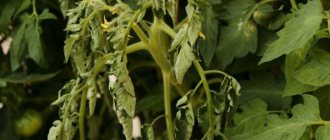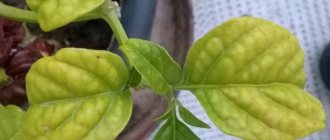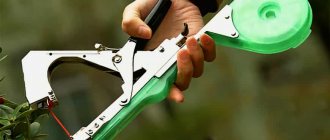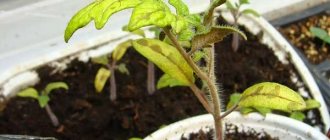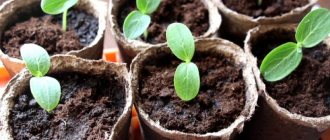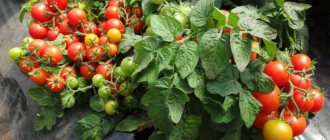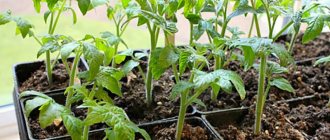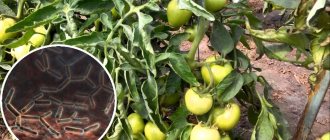The harvest depends on the quality of planting material. Before planting plants in the ground, their condition is assessed. Often, beginners are faced with the fact that young tomato seedlings grow pale and thin. When such a problem occurs, it is important to know what to do in order to identify and eliminate the causes of unhealthy plant appearance. Many gardeners believe that such seedlings are too weak and it will not be possible to grow good tomatoes from them.
However, plants can be revived. If you create optimal conditions for them, you can grow excellent bushes from elongated seedlings and harvest an excellent harvest from them. Tomatoes love light and warmth, but do not tolerate drought. Temperature disturbances, moisture deficiency or insufficient lighting affect the appearance of seedlings and their health.
Causes of pale seedlings
Picking done at the wrong time can cause tomato seedlings to turn pale.
Photo: propomidory.ru There are quite a few sources of the problem:
- lack or excess of mineral elements;
- lack of light;
- waterlogging;
- the temperature regime is violated;
- the moment of picking was missed.
The situation can be corrected by regulating the external conditions in the room with seedlings and stabilizing care. It is important to know what to feed tomatoes for good growth and development.
Reason 1. Dense sowing. Thickened plantings of seedlings lead to stretching of plants. Intertwining of roots disrupts the flow of oxygen. The same effect is created when sowing seeds in small containers. These factors lead to a weak and pale culture.
Solution. Transplant seedlings as they grow at least 2 times with simultaneous picking.
Reason 2: Not enough nitrogen. Light green leaves of seedlings will “tell” about a lack of nitrogen.
Solution. Dilute a tablespoon of Urea in 10 liters of water. Carry out unscheduled root feeding.
Reason 3. Not enough potassium. Plants with whitish, curled leaf blades require potassium supplementation.
Solution. A ten-liter bucket of water will require 10 g of potassium monophosphate. Feed at the root.
Reason 4. Not enough iron. With a lack of iron, the leaves turn white, the veins remain green.
Solution. Chlorosis in seedlings is treated with iron chelate (1 g per 10 liters of water). Irrigate the composition over the leaves.
Reason 5. Not enough copper. Symptoms of element deficiency include dull green leaves with white tips.
Solution. You can correct the situation with the help of copper sulfate. Dissolve 1 g of powder in 4 liters of water. Spray the seedlings 2 times every 2 weeks.
Reason 6. Lack of light. For some natural reasons (daylight is still short, cloudy weather outside) the seedlings begin to lack sunlight. Tomatoes are reaching for the sun. To the detriment of the development of the root system, the plant devotes energy to receiving a dose of sunlight. The stem stretches and becomes thinner.
Solution. Choose the most illuminated window sill for installing boxes with seedlings. In bad weather, illuminate the plants with special lamps. Plants will receive sufficient light when illuminated for 12 hours.
Reason 7. High room temperature. For normal growth of seedlings, the optimal air temperature is +18 ºC. It can be lower by 2-3 degrees.
Solution. Ventilate the room frequently. When warming reaches +15 °C, take the plants out into fresh air for hardening.
User Homochka advises:
“We water, feed with Ovary or any other mineral fertilizer for seedlings (Ovary is better for seedlings, because it also contains humates (organic matter)). We loosen it with a fork carefully so as not to damage the roots; you can simply pierce it with a knitting needle in several places to ensure oxygen access..."
Source www.u-mama.ru
Tips to resolve the problem
- If the reason is waterlogging of seedlings, the number and volume of watering should be limited.
- Do not let the tomato seedlings freeze; if necessary, they should be covered with film.
- To avoid oxygen starvation, do not allow the soil around the roots to harden, loosen it in time.
- The lack of light is solved with additional lighting. To artificially extend daylight hours, lamps must be used at least six hours a day.
- If the leaves have become light green or yellowed due to excessive lighting, create the opportunity for normal rest for the seedlings at night without additional light. Also don't forget about feeding.
- A plant transplanted from a cramped container in a timely manner will immediately feel better.
- Do you know for sure that the leaves turn pale due to problems with the root system? So, don’t rush to do anything. Why? The tomato itself will cope with this problem after some time.
Problems with a lack of nutrients can only be eliminated by applying properly selected fertilizers.
Measures to prevent blanching of tomato leaves
Tomato planting material can be disinfected in a solution of “Fitosporin” (price - 75 rubles) or potassium permanganate
- Soil treatment before sowing
Tomatoes can lose their foliage color due to damage to the root system by pathogenic fungi.
In order to prevent diseases, the soil must be disinfected before sowing:
- heat in the oven;
- freeze;
- spill with manganese solution.
Disinfect the soil before sowing seeds
- Timely feeding
Before planting tomatoes in the ground at home, feed them no more than 3 times. Unscheduled additions should be made only in case of a deficiency of nutrients.
Don't overdo it with nitrogen supplements
- Proper watering
Do not allow the soil to dry out. But overwatering will lead to rotting of the roots and the development of diseases.
It is optimal to water when the surface of the soil in the nurseries becomes dry. Be sure to make drainage holes in the seedling cups.
Water seedlings when the soil is dry
Viral diseases
Weak, twisted, thinned tomato seedlings may indicate infection of the seeds with viral pathogens. In this case, the deformity of the seedlings appears for no apparent reason, even in favorable conditions - with normal lighting and optimal water conditions, moderate air temperature, high-quality substrate, and lack of thickening.
Viral infections of tomatoes cannot be treated, and diseased plants will not produce a full harvest. It is necessary to purchase seeds only from reliable producers. To obtain your own seed material, choose typical tomatoes from the most productive and healthy bushes.
Rules for fertilizing tomatoes
In order for seedlings to be strong and healthy, they need to be fed.
Photo: veselyi-yrozhainik.ru Rule 1. Observe fertilizing periods
First deposit
At the stage of two true leaves, feed the seedlings with low concentration nitrogen fertilizers.
Second contribution
Add the next additive after the picking procedure. 10 days must pass from the moment of the dive.
Third contribution
A couple of days before planting in open ground, fertilize with a complex composition including nitrogen, phosphorus and potassium.
Additive composition:
- superphosphate - 20 g;
- urea - 10 g;
- potassium chloride - 15 g;
- water - 10 l.
Of the purchased products, I use, for example, complex mineral fertilizer "Agricola" (price - 12-15 rubles), "Athlete" (price - 13 rubles)
Rule 2. Add additional fertilizing
What to do if, while observing all agrotechnical rules (lighting, temperature, hardening, diving), seedlings stretch out and lose their green color?
The reason may be a lack of macro and microelements. To correct the situation, unscheduled feeding with the specialized mineral product “Athlet”. Fertilizer will stabilize plant growth.
Rule 3. Use folk recipes
To achieve maximum effect, alternate mineral supplements with organic fertilizers.
Ash infusion:
- Stir a tablespoon of the substance into 2 liters of water;
- leave for 24 hours, strain.
Baker's yeast infusion:
- For 10 liters of warm water, take a packet of yeast (10 g), 3-4 tbsp. l. granulated sugar;
Dissolve yeast and sugar in water and leave to ferment in a warm place for 2 days.
How to reduce the length of a sprout
Video: How to feed tomato seedlings to make them plump? | toNature.Info
Video: Tomato seedlings are pale and thin - what to do.
The so-called stepsons, that is, side stems, can be sprouted in water and planted in the ground. They will give an excellent harvest, and without them the load on the plant will decrease during the fruiting period. Between the fifth and sixth leaves, the stem can be cut and the upper part placed in a glass of water for further germination. Over time, additional shoots form at the cut site; all of them must be removed and only the top two left. The tomato is planted in the greenhouse after 25 days. The two upper branches should be tied separately. To prevent the plant from experiencing heavy load, 4 fruit clusters on each branch are enough.
Rules for caring for tomato seedlings at home
| Rule 1. Water in moderation 1. For irrigation, use warm, settled water. 2. Start watering the hatched sprouts on the 3rd day. 3. Determine the need for watering based on the following signs:
Pierce the ground with a wooden stick at the edge of the nursery.
5. DO NOT water seedlings from above onto the leaves. In dry indoor climates, occasionally refresh the sprouts with a fine spray bottle | |
| Rule 2. Loosen regularly Oxygen is necessary for the normal development of any plant. When loosening, air circulates more freely at the roots. 1. You can loosen 2 days after watering. 2. Hill up the sprouts a little first. Procedure:
3. Carry out the event after each watering | |
| Rule 3. Dive on time 1. When 2 true leaves appear, perform a dive. 2. Prepare cups with drainage holes. 3. The day before the procedure, water the plants. 4. Pour soil for seedlings into containers and make an indentation with a teaspoon. 5. Carefully remove the seedling with a spoon or wooden spatula and shake off the soil from the roots. 6. Shorten the main root by 1/3 with nail scissors (disinfect in advance). 7. Place the sprout in the hole and straighten the root network. 8. Sprinkle soil up to the cotyledon leaves, compact them at the stem. 9. Lightly water the tomatoes around the stem |
Temperature
For comfortable growth of tomatoes, a temperature ranging from 22 to 27°C is required. Night thermometer readings should not be lower than 16°C. The difference between day and night temperatures can be no more than five degrees.
To create such conditions, it is recommended to construct film shelters. They must be airtight and wind resistant.
Tomatoes can easily withstand heat of 40°C for just two days. After this, the photosynthesis process in the crop stops.
Vegetable growers recommend leaving the windows and doors of the greenhouse open during hot summer periods. If the vegetable beds are located in the open air, a shading canopy should be built.
Abundant morning watering will help plants withstand extreme heat without damage. You should water the root zone, trying to prevent moisture from getting on the tomato foliage.
On a note
- Use settled water. To prepare complex mineral mixtures and for irrigation, use settled water at room temperature.
- Pay attention to the presence of chlorine in the preparations. Tomatoes respond poorly to this trace element.
- Apply mineral fertilizers according to the norms and on time . Plants from excess nitrogen fertilizers, for example, can dramatically gain growth and green mass. In this case, the seedlings will not survive until they are planted in a permanent place.
Natural organic fertilizers
When growing tomatoes for their own consumption, gardeners try not to use chemical fertilizers.
Tomatoes feel great after providing them with natural nutrients:
- Yeast. 10 grams are diluted in a bucket of water. pressed live yeast. Such a solution not only contains nutrients, but also revitalizes the earth, triggering the formation of “living” soil;
- Ash. Wood ash contains a lot of nitrogen, potassium, calcium and phosphorus necessary for plants. It can be poured into the holes, or watered with infusion of ash.
- Iodine. Dissolve 10 drops of iodine in a bucket. The solution should only be poured onto the ground, avoiding contact with the plant. An iodine solution accelerates the formation of fruits and increases their weight.
- Manure. Watering with mullein infusion is carried out no more than once every 2 weeks. To prepare an infusion for 1 liter of manure, take a bucket of water and add 1 tbsp. ash and 1 tbsp. double superphosphate, leave for 24 hours. After fermentation has stopped, it is necessary to dilute the infusion with water before watering;
- Bird droppings. This is a very concentrated fertilizer; to feed seedlings, it must be diluted with water in a ratio of 1:30.
- Herbal infusion. Weeds (nettle, dandelion, wood lice, etc.) are placed in a 20-liter barrel, filled with water and left in the sun to ferment for a week. After fermentation, the infusion is filtered and stored in the shade. Water with infusion, diluting 1 liter of water in a bucket;
- Humates. Natural humates, which are universal organomineral fertilizers, are used in crop production. When using humate, you cannot use chemical phosphorus and calcium fertilizers; they form insoluble compounds.
What fertilizer to use and what to feed the seedlings depends on the preferences of the gardener. You can combine natural organic products and use chemicals with them.
How to determine what feeding is needed and what substances are missing
Most often, a deficiency of certain substances in seedlings appears when grown in ordinary garden soil. You can notice which element the plants are lacking by the following signs:
- With iron deficiency, seedlings begin to suffer from chlorosis. This condition manifests itself by lightening the leaf plate, on which brighter veins begin to stand out.
- If the stem and underside of the leaves have acquired a rich purple hue, this indicates a lack of phosphorus.
- A lack of nitrogen makes itself known by yellowing and possible falling of leaves. However, the same symptom will be observed with excessive watering. Therefore, first analyze how proper the care of the seedlings was.
If such changes occur, it will be necessary to apply the appropriate fertilizer to eliminate the deficiency of these elements. For this purpose, both chemical fertilizers and improvised means are used, which are found in every home.
The main thing is not to rush!
Some gardeners sin by rushing to feed seedlings prematurely - as soon as the first shoots appear above the surface of the ground. Meanwhile, the rapid flow of fertilizers and nutrients can only do harm. The root system of seedlings is still too weak to absorb large amounts of micro- and macroelements.
It is better to feed the seedlings for the first time when 3-4 true leaves appear on the plants, 2 weeks after picking. We are talking not only about fertilizing, but also about growth stimulants/regulators (Epin, Atlet). Most drugs are recommended to be used (and the instructions say so) after picking, in the phase of 3-4 true leaves.
Low iron
In this case, the plant stems are affected first, and then chlorosis spreads to the leaves. Iron is low in calcareous soils that are poorly saturated with oxygen or if there are large amounts of heavy metals.
The tomato bush looks like it is burning out. The green tone of the foliage will quickly return to the iron sulfate solution. At first the veins will bloom. This is the first sign of plant recovery.
Lack of magnesium
The leaves wither, turn pale, a brownish tint appears between the veins, gradually the entire leaf area becomes covered with brown spots, but the veins often remain green.
As a result, the leaves curl upward and fall off. Spraying with magnesium nitrate will relieve the problem. The solution is made simply: 1 small spoon of nitrate per bucket of water.
Features of the lesion
The process of identifying the pathogen is complicated by the fact that fungi and bacteria that infect tomato seedlings have similar characteristics. For these reasons, the effect of treatment may be zero.
- Fungal blackleg is controlled with fungicides.
- The bacterial variety of the disease is almost impossible to cure.
They feed on plant debris. If plant residues become scarce, saprophytes begin to eat living organic matter, among which they prefer the softest tissues. That is, seedlings and young leaves.
Bacterial rot affects not only the lower part of the stem, but also the leaves and buds. The infection is transmitted from seedling to seedling, especially in dense plantings. It most often develops in high humidity and poor air circulation.
Fungal and bacterial diseases differ in the nature of the discharge. Transparent mucus at the site of damage to the stem indicates a bacterial type of disease.
The fungus spreads slowly and there is no significant lesion on the plant. The stem may turn gray or dark green rather than black. First of all, the fungus attacks the root system.
When there is no zinc
Pitting corrosion will appear on the leaves, as if they were “sprinkled with freckles.” The veins will remain in a rich green tone, which will mislead an experienced summer resident, since this is typical for a lack of iron.
If it is precisely determined that tomato bushes lack zinc, zinc sulfate will save the situation. In addition, plants can be sprayed with a solution of zinc sulfate.
We feed with folk remedies
A remedy that is extremely useful for seedlings throughout the entire period of growing on the windowsill is an infusion of onion peels. They can replace water during each watering or be used from time to time. An infusion of onion peels acts as a soft fertilizer, saturating the soil with a large amount of useful substances. Preparing the infusion is very simple:
- Place 2 handfuls of onion peels in a liter jar and fill with hot water (not boiling water). Leave for a day, then filter and water the seedlings at the root using a watering can with a narrow neck. There is no need to further dilute the product.
